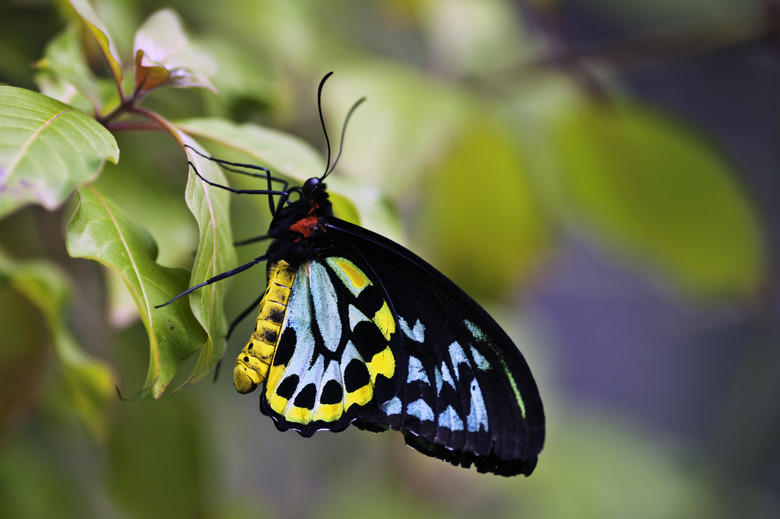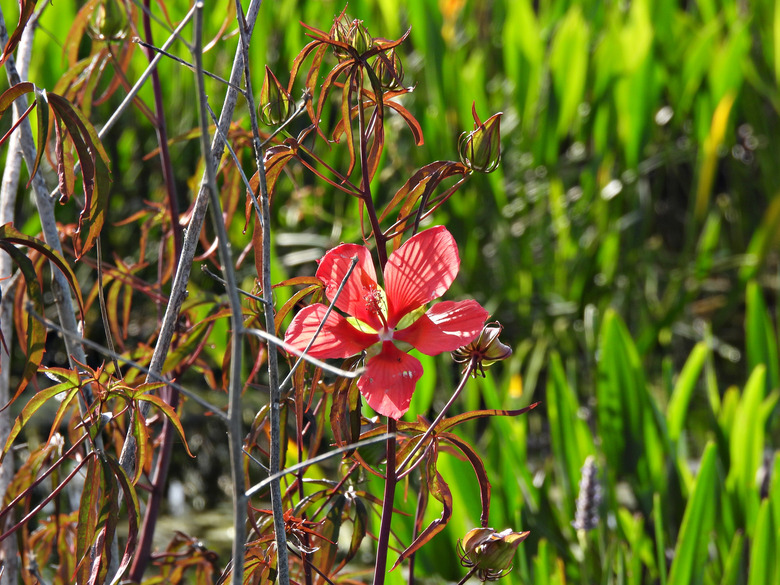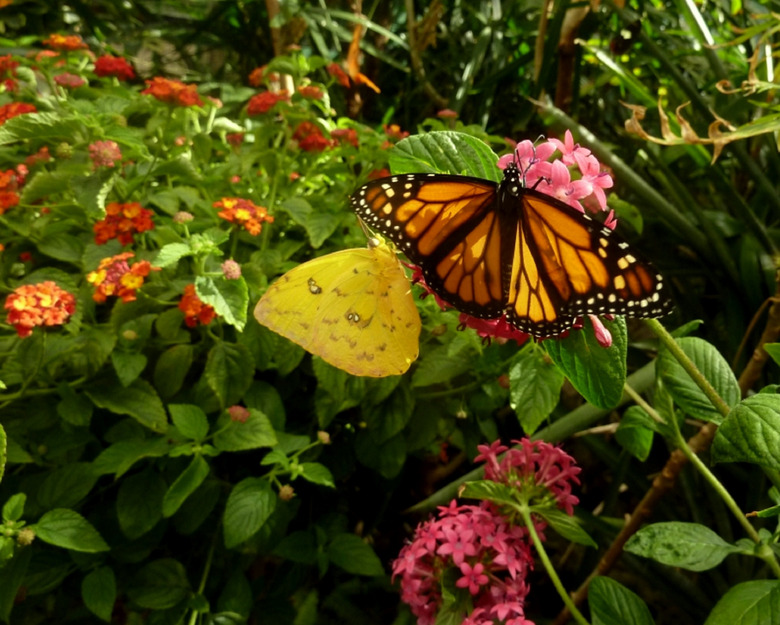What Is A Rain Garden, And How Does It Work?
We may receive a commission on purchases made from links.
Eco-friendly gardening enhances the landscape by replacing nonnative grasses with native plants, reducing water and fertilizer usage, and providing a habitat for pollinators and wildlife. When renovating a landscape, the question "what is a rain garden?" may arise during the planning process. As part of an overall sustainable landscape plan, a rain garden helps move rain and stormwater away from the house and into the soil without diverting it onto neighboring properties or into storm drains.
What Is a Rain Garden?
What Is a Rain Garden?
Creating a rain garden helps you direct rain and stormwater away from your home's foundation and reduces runoff, allowing the water to slowly soak into the soil. Elements of a rain garden include a shallow depression to temporarily hold water; deep-rooted and moisture-tolerant plants; and an inflow and an outflow that may lead to another part of the garden or in some cases, a drain or dry well.
Two Types of Rain Gardens
There are essentially two types of rain gardens: infiltration and filtration. Infiltration rain gardens are set up to slow water runoff so it has time to soak into the mulch and underlying soil in the rain garden, while the filtration type is designed to clean and filter the water through layers of mulch, soil, and gravel and then carry away the excess in a French drain or other drainage system.
Most residential rain gardens are the infiltration type. This type is generally less labor-intensive than a filtration rain garden, as it doesn't require the installation of an underground drain. There are several factors that help determine which is the best type for your site:
- Soil type
- Groundwater and bedrock depth
- Distance from hardscaping and utilities
- Slope of the property
- Amount of runoff
Rain Garden vs. Bioswale
A rain garden design may or may not incorporate one or more bioswales to direct excess water into the garden. A bioswale is similar to a rain garden, designed to slow the rush of stormwater and facilitate its absorption into the soil. Instead of using a simple depression like a rain garden, a bioswale features a shallow channel planted with an assortment of plants.
On a steep slope, a bioswale often features a berm on the downhill side to help keep the water flowing in the desired direction across the slope without contributing to erosion. It may follow the contours of the landscape or be a simple channel for the water. A bioswale may be designed as a grass-covered, gently sloping "valley" or a rock- and plant-lined dry creek that slows the water so it infiltrates the soil and then directs the remainder into a rain garden or storm drains. In commercial applications, bioswales are installed to help capture pollutants in the water running off parking lots or other hardscape before it flows into storm drains.
Benefits of a Rain Garden
Benefits of a Rain Garden
In addition to mitigating the impact of stormwater and flooding on urban and suburban neighborhoods, streets, and local waterways, bioswales and rain gardens provide valuable wildlife habitat, reduce pollutants, replenish ground water, and beautify commercial and residential landscapes. Planted with native wildflower, shrub, and tree species, a rain garden attracts pollinators, like butterflies, bees, and hummingbirds, as well as songbirds and other wildlife.
Rain gardens are versatile and can take almost any shape. A garden can be a focal point in the center of a lawn or simply a narrow strip between a house and sidewalk. Many homeowners use rain gardens to deal with excess water flowing from downspouts or to prevent water from pooling in specific areas after heavy rainfall, especially when runoff causes erosion or leads to wet basement or foundation problems.
Things Needed
-
Sod cutter, optional
-
Rototiller, optional
-
Shovel
-
Rake
-
Stakes
-
String or garden twine
-
Compost
-
Shredded hardwood mulch
-
Plants
How to Make a Rain Garden
How to Make a Rain Garden
Before creating a rain garden, consider the location and soil type. A persistent boggy spot in the yard is not the place for a rain garden, as the garden's purpose is to allow water to soak into the soil. If the lowest spot is boggy or contains heavy clay soil, filling the low spot and installing a drain or bog garden may be a better solution. A rain garden belongs between a water source, such as a downspout, and the lowest part of the yard, street, and/or storm drain, or in an area of the yard that is slower to drain after heavy rain events but does not permanently retain the water.
1. Plan the Rain Garden
Whether it will be a front or backyard rain garden, take time to measure the available space and determine the direction of the inflow and outflow. If the yard includes a slope between the water source and the storm drain, plan for a berm on the low side of the garden to keep the rain garden level so the water can pond for a few hours or a day while it soaks into the soil.
In addition, call 811 for assistance in locating any underground utilities before digging. The Underground Service Alert will contact the local utilities to mark the location of their underground lines. Follow these other tips for best results:
- Have the soil tested and check the infiltration rate (see below).
- Avoid poorly draining soil and/or shallow rock outcrops or bedrock.
- Maintain the following minimum distances:
- 10 feet from the foundation and 20 if the home has a basement
- 25 feet from a septic system and 50 feet if downslope from a septic field
- 25 feet from a well
- Consult with a landscape designer if the slope is more than 12 percent, or select a different site.
- Consider where water will flow if it overflows the garden basin.
2. Test the Water Infiltration Rate
Before finalizing the location of a commercial or residential rain garden, test how quickly water infiltrates the soil. The goal of a rain garden is for the water to drain into the soil within 24 to 48 hours. To test the drainage:
- Dig a hole that's 8 inches wide and deep.
- Fill the hole with water.
- Wait for two hours and then fill it with water to within 1 inch of the top of the hole.
- Use a ruler or tape measure to measure and record the depth of the water.
- Measure and record the depth of the water every 15 to 30 minutes in sandy soil or once per hour in clay soil.
- Calculate the infiltration rate by dividing the number of inches dropped (round up to the nearest inch) by the number of hours and then multiply by 24 to find how many inches of water will soak into the soil each day.
Use the final number from the calculation to determine how deep to dig the rain garden pool. For example, if the number is 9.6, the rain garden's basin should be 10 inches deep. However, no matter how well-draining the soil, Purdue University Extension recommends installing a basin no deeper than 18 inches.
3. Dig the Rain Garden
Lay out the edges of the rain garden using stakes and string, spray paint, or a garden hose. If mowing will be necessary around the perimeter, double-check to ensure that the mower will fit between existing trees and shrubs. Also lay out and build a swale or a dry creek leading from the house gutters into the rain garden. Then:
- Remove any existing lawn or other vegetation.
- Dig a shallow, flat-bottom basin up to 18 inches deep with sloping sides.
- Add a firmly tamped berm to the low sides of the basin and an outlet to release excess water.
- Add topsoil, compost, and other soil amendments as needed to increase the drainage inside the rain garden.
Choosing Rain Garden Plants
Choosing Rain Garden Plants
Rain garden plants must tolerate a range of dry, average, and wet conditions. Depending on the local climate, the rain garden may only fill with water during monsoon conditions and stay dry for most of the year, or it may fill and refill multiple times during the fall, winter, and spring. When planting the rain garden, use native species that thrive in the relevant U.S. Department of Agriculture plant hardiness zones whenever possible and plan for three levels of water tolerance:average to dry soil (highest level), average soil moisture (middle level), average to moist soil (lowest level).
Lay out the garden, arranging the plants from short to tall, front to center, or back depending on the design. Before planting, you can add large rocks or small boulders as a decorative touch that's also functional for mitigating erosion. Just make sure the rocks are not so large or that they fit so tightly together that they divert water around the rain garden. After planting, add a 2- to 3-inch layer of shredded hardwood mulch.
Planting Water-Tolerant Species
The center of the rain garden stays moist the longest, requiring plants that tolerate average to wet conditions. It is also the prime location for a focal point, such as a small tree or flowering shrub. Among the suitable shrubs and small trees for a rain garden are:
- American cranberry bush (Viburnum opulus var. americanum, formerly known as Viburnum trilobum, USDA zones 2-7)
- Pagoda dogwood (Cornus alternifolia, USDA zones 3-7)
- Pussy willow (Salix discolor, USDA zones 4-8)
- Red buckeye (Aesculus pavia, USDA zones 4-8)
Other water-loving plants, including bulbs and rhizomes, include:
- Cannas (Canna spp., USDA zones 7-10)
- Southern blue flag iris (Iris virginica, USDA zones 5-9)
- Creeping spike rush (Eleocharis palustris, USDA zones 3-8)
- American blue vervain (Verbena hastata, USDA zones 3-8)
- Scarlet rose mallow (Hibiscus coccineus, USDA zones 5-9)
Selecting Plants for Margins
The transitional plants, selected for the inner sloping edges of the rain garden, generally prefer a medium amount of moisture and tolerate soils that are occasionally wet. These may include:
- American hazelnut (Corylus americana, USDA zones 4-9)
- Swamp milkweed (Asclepias incarnata, USDA zones 3-6), which is a food source for monarch butterfly caterpillars
- New England aster (Symphyotrichum novae-angliae, USDA zones 4-8)
- Wild bee balm/bergamot (Monarda fistulosa, USDA zones 3-9)
Choosing the Berm Plants
The borders of the rain garden, depending on the local climate, transition from the berm to the rest of the landscape. These are often water-wise plants that prefer dry to medium soils:
- Bush honeysuckle (Diervilla lonicera, USDA zones 3-7)
- Anise hyssop (Agastache foeniculum, USDA zones 4-8)
- Obedient plant (Physostegia virginiana, USDA zones 3-9)
Potential Problems With Rain Gardens
Potential Problems With Rain Gardens
While rain gardens provide many benefits, caution is necessary when planning and installing the basin, plants, and overflow outlet. In some municipalities, changing the natural flow of water ranges from problematic to illegal. Generally, installing a rain garden is safe as long as it is not diverting stormwater away from or onto neighboring properties.
In addition, many water-loving plants tend toward invasiveness. Shrubs and trees spread by root suckers to form thickets, rhizomes spread underground, and seeds are scattered by birds and wildlife. Even some natives can become invasive when planted outside of their natural range.
Rain Garden FAQs
Rain Garden FAQs
Do mosquitoes breed in rain gardens?
Mosquitoes do not breed in rain gardens because typically there is no standing water for extended periods. The cycle from egg to adult mosquito is 7 to 10 days, while the water in a rain garden should drain within 12 to 24 hours.
Do rain gardens need watering?
Rain gardens do need watering, especially in the first two years while the plants are becoming established. Water during dry spells, every 7 to 14 days during the first year, and every 2 to 4 weeks during the second year.
Do rain gardens need fertilizing?
Typically, rain gardens do not need fertilizer. An inch or two of compost every year provides sufficient nutrients for most native plants. Overfertilizing contaminates the stormwater and encourages algae overgrowth in waterways.
Are rain gardens hard to maintain?
Like any garden, a rain garden requires a certain amount of weeding, trimming, and pruning, and you must replenish the mulch. However, routine care is less time-consuming than maintaining a lawn.




